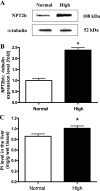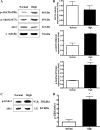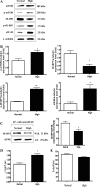High dietary inorganic phosphate enhances cap-dependent protein translation, cell-cycle progression, and angiogenesis in the livers of young mice
- PMID: 18703640
- PMCID: PMC2575911
- DOI: 10.1152/ajpgi.90213.2008
High dietary inorganic phosphate enhances cap-dependent protein translation, cell-cycle progression, and angiogenesis in the livers of young mice
Abstract
Inorganic phosphate (P(i)) plays a key role in diverse physiological functions. Recent studies have indicated that P(i) affects Akt signaling through the sodium-dependent phosphate cotransporter. Akt signaling, in turn, plays an important role in liver development; however, the effects of high dietary P(i) on the liver have not been investigated. Here, we examined the effects of high dietary phosphate on the liver in developing mice. We found that high dietary P(i) increased liver mass through enhancing Akt-related cap-dependent protein translation, cell cycle progression, and angiogenesis. Thus careful regulation of P(i) consumption may be important in maintaining normal development of the liver.
Figures







Similar articles
-
High dietary inorganic phosphate affects lung through altering protein translation, cell cycle, and angiogenesis in developing mice.Toxicol Sci. 2007 Nov;100(1):215-23. doi: 10.1093/toxsci/kfm202. Epub 2007 Aug 13. Toxicol Sci. 2007. PMID: 17698515
-
A high inorganic phosphate diet perturbs brain growth, alters Akt-ERK signaling, and results in changes in cap-dependent translation.Toxicol Sci. 2006 Mar;90(1):221-9. doi: 10.1093/toxsci/kfj066. Epub 2005 Dec 7. Toxicol Sci. 2006. PMID: 16338957
-
Low dietary inorganic phosphate affects the brain by controlling apoptosis, cell cycle and protein translation.J Nutr Biochem. 2008 Jan;19(1):16-25. doi: 10.1016/j.jnutbio.2006.12.021. Epub 2007 May 16. J Nutr Biochem. 2008. PMID: 17509857
-
Low dietary inorganic phosphate affects the lung growth of developing mice.J Vet Sci. 2009 Jun;10(2):105-13. doi: 10.4142/jvs.2009.10.2.105. J Vet Sci. 2009. PMID: 19461205 Free PMC article.
-
Anti-oncogenic potential of the eIF4E-binding proteins.Oncogene. 2013 Feb 7;32(6):671-7. doi: 10.1038/onc.2012.116. Epub 2012 Apr 16. Oncogene. 2013. PMID: 22508483 Review.
Cited by
-
Hydrogen phosphate selectively induces MDA MB 231 triple negative breast cancer cell death in vitro.Sci Rep. 2022 Mar 29;12(1):5333. doi: 10.1038/s41598-022-09299-2. Sci Rep. 2022. PMID: 35351930 Free PMC article.
-
High Inorganic Phosphate Intake Promotes Tumorigenesis at Early Stages in a Mouse Model of Lung Cancer.PLoS One. 2015 Aug 18;10(8):e0135582. doi: 10.1371/journal.pone.0135582. eCollection 2015. PLoS One. 2015. PMID: 26285136 Free PMC article.
-
An integrated understanding of the physiological response to elevated extracellular phosphate.J Cell Physiol. 2013 Jul;228(7):1536-50. doi: 10.1002/jcp.24312. J Cell Physiol. 2013. PMID: 23280476 Free PMC article.
-
The emergence of phosphate as a specific signaling molecule in bone and other cell types in mammals.Cell Mol Life Sci. 2011 Jan;68(2):205-18. doi: 10.1007/s00018-010-0527-z. Epub 2010 Sep 17. Cell Mol Life Sci. 2011. PMID: 20848155 Free PMC article. Review.
-
Soft tissue calcifications in chronic kidney disease-beyond the vasculature.Pflugers Arch. 2025 Aug;477(8):1037-1059. doi: 10.1007/s00424-025-03098-0. Epub 2025 Jun 5. Pflugers Arch. 2025. PMID: 40471241 Free PMC article. Review.
References
-
- Asnaghi L, Bruno P, Priulla M, Nicolin A. mTOR: a protein kinase switching between life and death. Pharmacol Res 50: 545–549, 2004. - PubMed
-
- Beck GR Jr, Moran E, Knecht N. Inorganic phosphate regulates multiple genes during osteoblast differentiation, including Nrf2. Exp Cell Res 288: 288–300, 2003. - PubMed
-
- Bremnes RM, Camps C, Sirera R. Angiogenesis in non-small cell lung cancer: the prognostic impact of neoangiogenesis and the cytokines VEGF and bFGF in tumours and blood. Lung Cancer 51: 143–158, 2006. - PubMed
-
- Calvo MS Dietary phosphorus, calcium metabolism, and bone. J Nutr 123: 1627–1633, 1993. - PubMed
Publication types
MeSH terms
Substances
Grants and funding
LinkOut - more resources
Full Text Sources
Molecular Biology Databases
Research Materials
Miscellaneous

